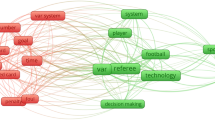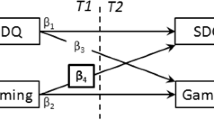Abstract
In 2015, daily fantasy football entered the fantasy sports market as an offshoot of the traditional, season-long form of the game. With quicker payouts and less commitment, the new activity has drawn comparisons to other forms of illegal gambling, and the determination of whether it is a primarily a game of skill or chance has become the center of the comparison. For the most part, legal commentators and society, in general, views traditional, season-long fantasy football as an innocuous, social activity governed equally by both skill and chance. Little evidence exists, however, about participant perception of skill and chance components in daily fantasy football. The current study surveyed 535 daily and traditional-only fantasy football participants in order to understand differences and similarities in the causality orientations of participation (skill or chance). In addition, enjoyment and anxiety were tested for mediating effects on causality orientations and consumption behavior. The results suggest the differences between the activities are not extreme. However, differences were found in which causality orientations influenced enjoyment and which emotion mediated the relationship between perceived skill and consumption.

Similar content being viewed by others
References
Breen, R. B., & Zuckerman, M. (1999). ‘Chasing’ in gambling behavior: Personality and cognitive determinants. Personality and Individual Differences, 27, 1097–1111.
Broman-Fulks, J. J., Urbaniak, A., Bondy, C. L., & Toomey, K. J. (2014). Anxiety sensitivity and risk-taking behavior. Anxiety Stress and Coping, 27, 619–632.
Brown, T. A. (2012). Confirmatory factor analysis for applied research. New York, NY: Guilford Press.
Casler, K., Bickel, L., & Hackett, E. (2013). Separate but equal? A comparison of participants and data gathered via Amazon’s MTurk, social media, and face-to-face behavioral testing. Computers in Human Behavior, 29, 2156–2160.
Cohen, J. (1992). Statistical power analysis for the behavioral sciences (2nd ed.). Hillsdale, NJ: Lawrence Erlbaum Associates.
Dawson, S., Bloch, P. H., & Ridgway, N. (1990). Shopping motives, emotional states, and retail outcome. Journal of Retailing, 66, 408–427.
Deci, E. L., & Ryan, R. M. (1985). The General Causality Orientations Scale: Self-determination in personality. Journal of Research in Personality, 19(2), 109–134.
Deci, E. L., & Ryan, R. M. (Eds.), (2002). An overview of self-determination theory: An organismic dialectical perspective. In Handbook of self-determination research (pp. 3–33). Rochester, New York: The University of Rochester Press.
Drayer, J., Shapiro, S. L., Dwyer, B., Morse, A. L., & White, J. (2010). The effects of fantasy football participation on NFL consumption: A qualitative analysis. Sport Management Review, 13, 129–141.
Dwyer, B. (2011a). Divided loyalty? An analysis of fantasy football involvement and fan loyalty to individual National Football League (NFL) teams. Journal of Sport Management, 25, 445–457.
Dwyer, B. (2011b). The impact of attitudes and fantasy football involvement on intentions to watch NFL teams on television. International Journal of Sport Communication, 4, 375–396.
Dwyer, B., & Kim, Y. (2011). For love or money: Developing and validating a motivational scale for fantasy football participation. Journal of Sport Management, 25, 70–83.
Dwyer, B., & LeCrom, C. W. (2013). Is fantasy trumping reality? The redefined National Football League experience of novice fantasy football participants. Journal of Contemporary Athletics, 7(3), 119.
Dwyer, B., Lupinek, J., & Achen, R. M. (2016). Fantasy v. reality: Exploring the BIRGing and CORFing behavior of fantasy football participants. Sport Marketing Quarterly, 26, 158–171.
Dwyer, B., Shapiro, S. L., & Drayer, J. (2013). Segmenting motivation: An analysis of fantasy baseball motives and mediated sport consumption. Sport Marketing Quarterly, 20, 129–137.
Ekkekakis, P., Hall, E. E., & Petruzzello, S. J. (1999). Measuring state anxiety in the context of acute exercise using the state anxiety inventory: An attempt to resolve the brouhaha. Journal of Sport and Exercise Psychology, 21(3), 205–229
Eriksson, K., & Simpson, B. (2010). Emotional reactions to losing explain gender differences in entering a risky lottery. Judgment and Decision Making, 5, 159–175.
Fantasy Sports Trade Association. (2016a). Industry demographics: Actionable insights and insightful data. Retrieved from http://fsta.org/research/industry-demographics/.
Fantasy Sports Trade Association. (2016b). Why fantasy sports is not gambling: Understanding a game of skill. Retrieved from http://fsta.org/research/why-fantasy-sports-is-not-gambling.
Farquhar, L. K., & Meeds, R. (2007). Types of fantasy sports users and their motivations. Journal of Computer-Mediated Communication, 12, 1208–1228.
Field, A. (2013). Discovering statistics using IBM SPSS statistics. London: Sage.
Fornell, C., & Larcker, D. F. (1981). Structural equation models with unobservable variables and measurement error: Algebra and statistics. Journal of Marketing Research, 18, 382–388.
Gagné, M., & Deci, E. L. (2005). Self-determination theory and work motivation. Journal of Organizational behavior, 26(4), 331–362.
Gouker, D. (2015). FanDuel studies: Seasonlong and daily fantasy sports players exhibit key differences. Legal Sports Report. Retrieved from http://www.legalsportsreport.com/370/fanduel-seasonlong-and-daily-fantasy-sports-players-differences/.
Graves, L. E., Ridgers, N. D., Williams, K., Stratton, G., & Atkinson, G. T. (2010). The physiological cost and enjoyment of Wii Fit in adolescents, young adults, and older adults. Journal of Physical Activity & Health, 7, 393–401.
Hackfort, D., & Schwenkmezger, P. (1989). Measuring anxiety in sports: Perspectives and problems. In D. Hackfort & C. D. Speilberger (Eds.), Anxiety in sports: An international perspective (pp. 55–74). Washington, DC: Hemisphere.
Hunter, M. (2016). DFS strategy: Multi-lineup generation and player exposure. RotoGraphs. Retrieved from http://www.fangraphs.com/fantasy/dfs-strategy-multi-lineup-generation-and-player-exposure/.
Kendzierski, D., & DeCarlo, K. J. (1991). Physical activity enjoyment scale: Two validation studies. Journal of Sport & Exercise Psychology, 13(1), 50–64.
Kim, J. Y., Shim, J. P., & Ahn, K. M. (2011). Social networking service: Motivation, pleasure, and behavioral intention to use. Journal of Computer Information Systems, 51(4), 92–101.
Kim, H. S., Wohl, M. J., Salmon, M. M., Gupta, R., & Derevensky, J. (2015). Do social casino gamers migrate to online gambling? An assessment of migration rate and potential predictors. Journal of Gambling Studies, 31, 1819–1831.
Koestner, R., & Zuckerman, M. (1994). Causality orientations, failure, and achievement. Journal of Personality, 62(3), 321–346.
Lee, W.-J., Kwak, D. H., Lim, C., Pederson, P. M., & Miloch, K. S. (2010). Effects of personality and gender on fantasy sports game participation: The moderating role of perceived knowledge. Journal of Gambling Studies, 27, 427–441.
Lesieur, H. R. (1979). The compulsive gambler’s spiral of options and involvement. Psychiatry, 42, 79–87.
Leykin, Y., & DeRubeis, R. J. (2010). Decision-making styles and depressive symptomatology: Development of the Decision Styles Questionnaire. Judgment and Decision Making, 5, 506–521.
Lloyd, K. M., & Auld, C. J. (2002). The role of leisure in determining quality of life: Issues of content and measurement. Social Indicators Research, 57, 43–71.
MacCrimmon, K. R., & Wehrung, D. A. (1986). Assessing risk propensity. In L. Daboni, A. Montesano, & M. Lines (Eds.), Recent developments in the foundations of utility and risk theory (pp. 291–309). Dordrecht, Netherlands: Springer.
Martin, R. J., Nelson, S. E., & Gallucci, A. R. (2016). Game on: Past year gambling, gambling-related problems, and fantasy sports gambling among college athletes and non-athletes. Journal of Gambling Studies, 32, 567–579.
McCormick, R. A., Russo, A., Ramirez, L., & Taber, J. I. (1984). Affective disorders among pathological gamblers seeking treatment. American Journal of Psychiatry, 141, 215–218.
Meyer, G., von Meduna, M., Brosowski, T., & Hayer, T. (2013). Is poker a game of skill or chance? A quasi-experimental study. Journal of Gambling Studies, 29, 535–550.
Morrison, M., Gan, S., Dubelaar, C., & Oppewal, H. (2011). In-store music and aroma influences on shopper behavior and satisfaction. Journal of Business Research, 64, 558–564.
Mowen, J. C., & Minor, M. (1998). Consumer behavior (5th ed.). London: Prentice-Hall.
Murphy, G. C., Foreman, P. E., Simpson, C. A., Molloy, G. N., & Molloy, E. K. (1999). The development of a locus of control measure predictive of injured athletes’ adherence to treatment. Journal of Science and Medicine in Sport, 2, 145–152.
Myrseth, H., Brunborg, G. S., & Eidem, M. (2010). Differences in cognitive distortions between pathological and non-pathological gamblers with preferences for chance or skill games. Journal of Gambling Studies, 26, 561–569.
Neighbors, C., Larimer, M. E., Markman Geisner, I., & Knee, C. R. (2004). Feeling controlled and drinking motives among college students: Contingent self-esteem as a mediator. Self and Identity, 3(3), 207–224.
Nesbit, T. M., & King, K. A. (2010). The impact of fantasy sports on television viewership. Journal of Media Economics, 23, 24–41.
Rodriguez, L. M., Neighbors, C., Rinker, D. V., & Tackett, J. L. (2015). Motivational profiles of gambling behavior: Self-determination theory, gambling motives, and gambling behavior. Journal of Gambling Studies, 31, 1597–1615.
Ryan, R. M., & Deci, E. L. (2006). Self-regulation and the problem of human autonomy: Does psychology need choice, self-determination, and will? Journal of Personality, 74, 1557–1586.
Ryan, R. M., Rigby, C. S., & Przybylski, A. (2006). The motivational pull of video games: A self-determination theory approach. Motivation and Emotion, 30, 344–360.
Sitkin, S. B., & Weingart, L. R. (1995). Determinants of risky decision-making behavior: A test of the mediating role of risk perceptions and propensity. Academy of Management Journal, 38(6), 1573–1592.
Solberg, P. A., Halvari, H., & Ommundsen, Y. (2013). Linking exercise and causality orientations to change in well-being among older adults: Does change in motivational variables play a role? Journal of Applied Social Psychology, 43, 1259–1272.
Stanton, J. M., Sinar, E. F., Balzer, W. K., & Smith, P. C. (2002). Issues and strategies for reducing the length of self-report scales. Personnel Psychology, 55, 167–194.
Steinberg, L. (2014). The fantasy football explosion. Forbes. Retrieved from http://www.forbes.com/sites/leighsteinberg/2014/08/29/the-fantasy-football-explosion/#bbb574b5458d.
Suri, S., & Watts, D. J. (2011). Cooperation and contagion in web-based, networked public goods experiments. PLoS ONE, 6(3), e16836.
Troy, D. (2014). Is fantasy football stressing you out? Advocate Health Care. Retrieved from http://www.ahchealthenews.com/2014/12/02/is-fantasy-football-stressing-you-out/.
Westbrook, R. A., & Black, W. C. (1985). A motivation-based shopper typology. Journal of Retailing, 61, 78–103.
Wulfert, E., Roland, B., Hartley, J., Wang, N., & Franco, C. (2005). Heart rate arousal and excitement in gambling: Winners v. losers. Psychology of Addictive Behaviors, 19, 311–329.
Author information
Authors and Affiliations
Corresponding author
Ethics declarations
Conflict of interest
The authors declare that they have no conflict of interest.
Ethical Approval
All procedures performed in studies involving human participants were in accordance with the ethical standards of the institutional and/or national research committee and with the 1964 Helsinki declaration and its later amendments or comparable ethical standards.
Appendix
Appendix

Rights and permissions
About this article
Cite this article
Dwyer, B., Weiner, J. Daily Grind: A Comparison of Causality Orientations, Emotions, and Fantasy Sport Participation. J Gambl Stud 34, 1–20 (2018). https://doi.org/10.1007/s10899-017-9684-4
Published:
Issue Date:
DOI: https://doi.org/10.1007/s10899-017-9684-4




